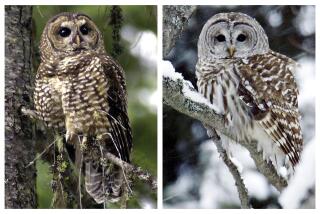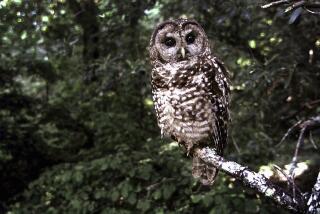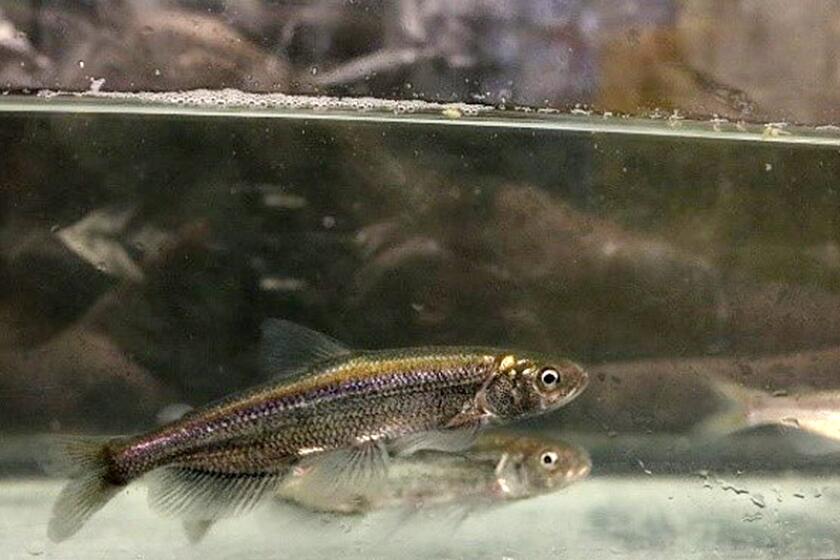First Fish, Now Bird May Win Protection at Expense of Tollway
- Share via
For the second time in a week, plans for the Foothill South toll road have run into a legal thicket.
In a decision issued Wednesday, U.S. District Court Judge Stephen Wilson ruled that within 60 days the U.S. Fish and Wildlife Service must begin identifying “critical habitat” across Southern California for the California gnatcatcher, a threatened bird. Wildlife officials have estimated that could total as much as 124,000 acres.
The designation could eventually halt construction that would disturb the bird. The federal agency, however, has a year to designate those areas.
Road projects that could be affected include two in Orange County: a proposed 16-mile extension of the Foothill toll road--called the Foothill South--and realignment of Laguna Canyon Road. Also affected could be work on state highways 125, 905, 78 and 76 in San Diego County and California 118 in Ventura County.
For the toll road, it is the second environmental hurdle to crop up this week. On Tuesday the Fish and Wildlife Service complied with an earlier judge’s order to set aside portions of several creeks--including two under the proposed toll road route--for an endangered fish, the tidewater goby.
Officials with the Los Angeles office of the environmental group Natural Resources Defense Council, which sued to get the ruling, said it is one more clear-cut indication that the toll road should not be extended.
“I don’t know how many times this needs to happen,” said NRDC lawyer Andrew Wetzler. “How many indications do we need that this is a biologically rich habitat, and it’s completely inappropriate to put a toll road through?”
Lisa Telles, a spokeswoman for the toll-road builder, the Orange County Transportation Corridor Agencies, downplayed the judge’s decision. The agencies have already been preparing to protect the gnatcatcher, like the goby, she said.
The road could be realigned, if necessary, or land containing coastal sage scrub, key to the songbird’s survival and nesting, could be set aside to compensate for habitat lost, Telles said.
NRDC officials also complained that the Fish and Wildlife Service has been dragging its feet in establishing critical habitats. The federal agency has now lost 17 cases in four states, resulting in orders to set aside critical habitat; the agency has set aside land in only four cases.
“The lengths to which the government is prepared to go to avoid its responsibility under the law is truly amazing,” said Wetzler.
Fish and Wildlife spokeswoman Joan Jewett said she had not seen the judge’s decision. But limited funding has made it extremely difficult to do the thorough analysis required for setting aside proper habitat, she said.
Jamie Rappaport Clark, director of the Fish and Wildlife Service, made a similar point in a June statement:
“In 15 years of implementing the Endangered Species Act, we have found that the designation of critical habitat . . . has provided little additional protection to most listed species while consuming significant amounts of funding.”
The agency’s total budget for 1999 is $802 million, of which Congress set aside a maximum of $5.7 million for critical-habitat work.
In his ruling, however, Judge Wilson wasn’t buying the argument.
“The Court does not doubt that Defendants (Fish and Wildlife) have limited resources and would prefer to conduct their work on the gnatcatcher in a more leisurely manner,” he wrote.
(BEGIN TEXT OF INFOBOX / INFOGRAPHIC)
Foothill Fight
The Transportation Corridor Agencies face environmental obstacles to construction of a final 16-mile section of toll road in South County.
More to Read
Sign up for Essential California
The most important California stories and recommendations in your inbox every morning.
You may occasionally receive promotional content from the Los Angeles Times.










